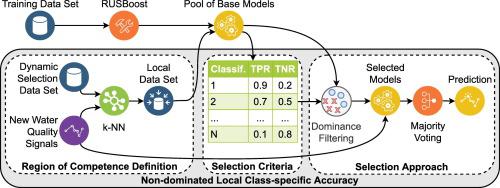Science of the Total Environment ( IF 8.2 ) Pub Date : 2020-09-15 , DOI: 10.1016/j.scitotenv.2020.142368 Victor Henrique Alves Ribeiro , Steffen Moritz , Frederik Rehbach , Gilberto Reynoso-Meza

|
The provision of clean and safe drinking water is a crucial task for water supply companies from all over the world. To this end, automatic anomaly detection plays a critical role in drinking water quality monitoring. Recent anomaly detection studies use techniques that focus on a single global objective. Yet, companies need solutions that better balance the trade-off between false positives (FPs), which lead to financial losses to water companies, and false negatives (FNs), which severely impact public health and damage the environment. This work proposes a novel dynamic multi-criteria ensemble selection mechanism to cope with both problems simultaneously: the non-dominated local class-specific accuracy (NLCA). Moreover, experiments rely on recent time series related classification metrics to assess the predictive performance. Results on data from a real-world water distribution system show that NLCA outperforms other ensemble learning and dynamic ensemble selection techniques by more than 15% in terms of time series related F1 scores. As a conclusion, NLCA enables the development of stronger anomaly detection systems for drinking water quality monitoring. The proposed technique also offers a new perspective on dynamic ensemble selection, which can be applied to different classification tasks to balance conflicting criteria.
中文翻译:

一种用于饮用水水质异常检测的新型动态多准则集成选择机制
提供清洁和安全的饮用水是来自世界各地的供水公司的一项关键任务。为此,自动异常检测在饮用水水质监测中起着至关重要的作用。最近的异常检测研究使用的技术专注于单个全局目标。但是,公司需要能够更好地权衡导致水务公司蒙受财务损失的误报(FP)和严重影响公共卫生并破坏环境的误报(FN)之间的权衡取舍的解决方案。这项工作提出了一种新颖的动态多标准集合选择机制,以同时解决这两个问题:非支配的局部类特定精度(NLCA)。此外,实验依赖于与时间序列相关的最新分类指标来评估预测性能。F 1得分。结论是,NLCA可以开发更强大的饮用水质量监控异常检测系统。所提出的技术还为动态集合选择提供了新的视角,可以将其应用于不同的分类任务以平衡冲突标准。











































 京公网安备 11010802027423号
京公网安备 11010802027423号